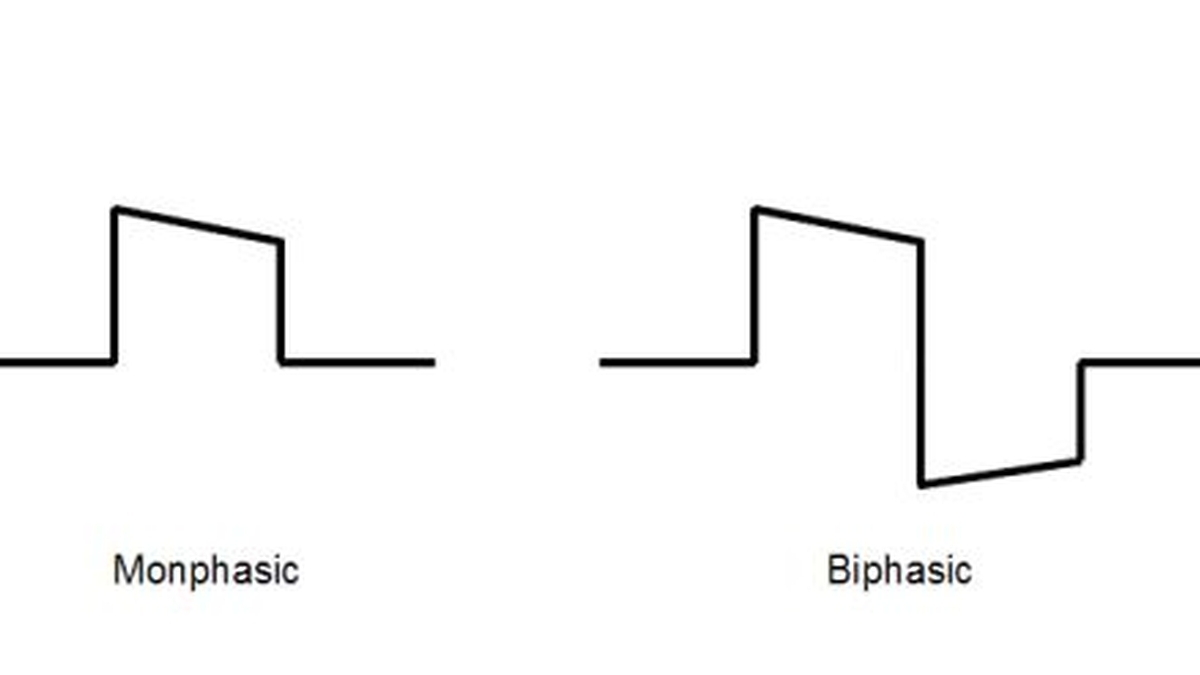Difference between a monophasic and biphasic defibrillator
Difference between a monophasic and biphasic defibrillator
 Monophasic and Biphasic defibrillator shock waveforms
Monophasic and Biphasic defibrillator shock waveforms
What is the difference between a monophasic and biphasic defibrillator?
Defibrillator is a device used to shock the heart back into action when it stops contracting due to a disorder of the rhythm known as ventricular fibrillation (VF). The electrodes used to deliver the shock could be either defibrillator paddles or patches, directly applied to the chest below the left collar bone and at the apex of the heart.
The direct current shock given can have a monophasic or biphasic waveform. In monophasic shock, the shock is given in only one direction from one electrode to the other. In a biphasic shock, initial direction of shock is reversed by changing the polarity of the electrodes in the latter part of the shock. Usually the initial voltage applied is higher than the reversed polarity shock. Biphasic waveforms were initially developed for use in implantable cardioverter defibrillators (ICD) and later adapted to external defibrillators. Biphasic truncated exponential waveform and rectilinear biphasic waveform are two types of biphasic waveforms used by different manufacturers. Defibrillators can sense the thoracic impedance and increase or decrease their internal resistance so that the selected level of energy is delivered to the subject.
Biphasic shocks are more effective than monophasic shocks and need lesser energy. Typically when 360 Joules are delivered for defibrillation in a monophasic defibrillator, 200 Joules are given in a biphasic defibrillator.
The proposed mechanism is that a single monophasic wave of energy is not able to depolarize all the myocardial cells. Some cells close to the electrode gets too much energy while those away from the electrode gets too little. Reversing the polarity helps to sweep off these cells as well. This response is sometimes called a ‘burping’ response of a biphasic waveform.
A prospective randomized evaluation compared monophasic and biphasic wave forms in 22 survivors of out of hospital cardiac arrest during implantation of a cardioverter defibrillator [1]. Of the patients, 15 (68%) had lower defibrillation threshold with biphasic pulse.
The lower energy delivered in biphasic defibrillation could theoretically reduce the potential damage to the heart muscle by the high voltage shock. This aspect was evaluated by W Tang, M H Weil, and S Sun [2]. They showed that biphasic waveform defibrillation at 150 Joules was as effective as conventional monophasic defibrillation with damped sine wave for restoration of spontaneous circulation. The energy delivered was significantly lower with biphasic defibrillation and was associated with significantly lower severity of post resuscitation myocardial dysfunction.
But a Cochrane Systematic Review could not confirm that biphasic defibrillators have an important effect on the success of defibrillation in persons with out of hospital cardiac arrest [3].
References
- G H Bardy, T D Ivey, M D Allen, G Johnson, R Mehra, H L Greene. A prospective randomized evaluation of biphasic versus monophasic waveform pulses on defibrillation efficacy in humans. J Am Coll Cardiol. 1989 Sep;14(3):728-33.
- W Tang, M H Weil, S Sun. Low-energy biphasic waveform defibrillation reduces the severity of postresuscitation myocardial dysfunction. Crit Care Med. 2000 Nov;28(11 Suppl):N222-4.
- Steven C Faddy, Paul A Jennings. Biphasic versus monophasic waveforms for transthoracic defibrillation in out-of-hospital cardiac arrest. Cochrane Database Syst Rev. 2016 Feb 10;2:CD006762.

